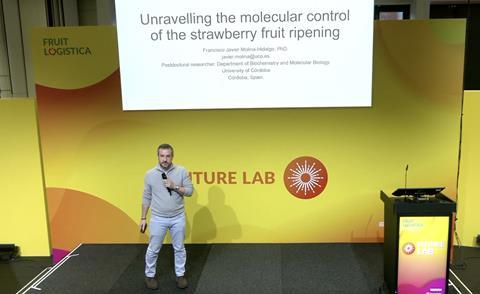Understanding the fruit ripening process will help develop new tools for crop improvement, visitors to the Future Lab stage heard

The final day of Fruit Logistica saw a deep dive into the complexities of the fruit ripening process, studying how understanding the molecular control of the process could benefit producers in the future.
Francisco Javier Molina-Hidalgo, postdoctoral researcher at the University of Córdoba in Spain, led the Future Lab session, explaining that his role was in biochemistry and molecular biology.
“We are focused on the genes,” he explained. ”We look at how the fruit’s genes affect two main areas, development and ripening.”
This meant studying on the first hand cell division and expansion, and the number and distribution of achenes, and on the other organoleptic properties, colouration changes and flavour, he said.
Molina-Hidalgo discussed the activation of genes and the hormonal regulation and development during the strawberry ripening process.
“The strawberry is classified as a non-climateric fruit,” he continued. “Unlike climateric fruits, where ethylene is the main hormone controlling ripening, in strawberries the main hormone is abscisic acid (ABA).”
The research groups were mainly focused on those genes that were regulators, controlling most of the processes inside the organisms such as hormones, flavonoids, sugar metabolism and more.
He said that candidate genes were selected through a process of comparison, such as red versus green fruit, allowing them to calculate which were linked specifically to ripening.
“Following this strategy, we have already characterised and discovered the function of genes related to colour, flavour, shape of the fruit and others related to pathogen response, as well as genes that could be potentially the target of biotechnological improvement of the fruit.”
Molina-Hidalgo then presented a specific focus on a recent paper published in The Plant Journal, entitled ’FaMYB123 interacts with FabHLH3 to regulate the late steps of anthocyanin and flavonol byosynthesis during ripening’.
Once he had run through the study, he emphasised how the research being done in places such as his university could be easily applied by companies producing new varieties or developing breeding programmes.



